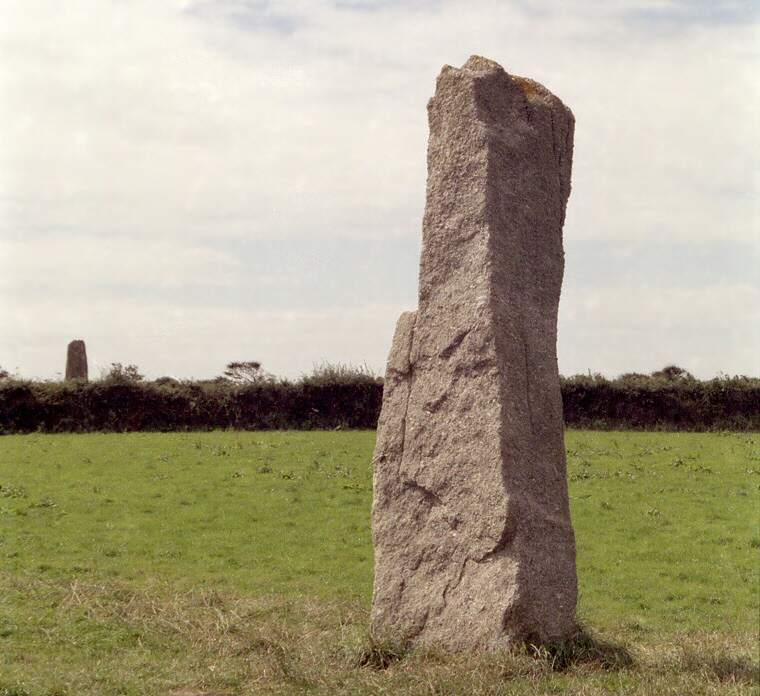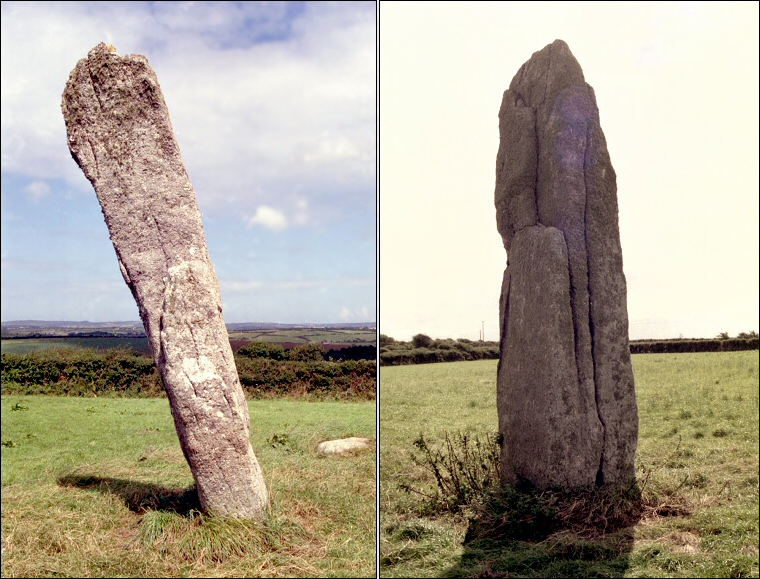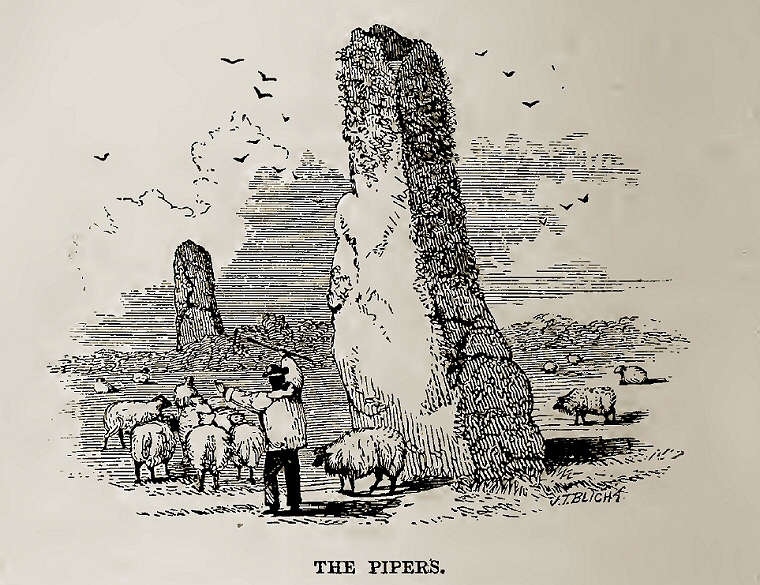
View of both of the Pipers of Boleigh, pity about the hedge that separates them.
This pair of massive standing stones known as the Pipers of Boleigh are said to be the tallest surviving monoliths in Cornwall. The stone at OS grid ref. SW 4348 2475 (image below right and beyond the hedge above) measures some 4.7 metres tall and is heavily cracked and splintered giving it a rather phallic appearance from some angles. Its partner, 90 metres away to the northeast at grid ref. SW 4355 2481 (in the foreground above and below left), leans quite badly but still measures a respectable 4.2 metres tall.
The stones are located about 300 metres to the northeast of the Merry Maidens but are separated from the stone circle by the B3315 road and also separated from each other by an inconveniently placed hedge that forms part of a field boundary. They were almost certainly built as a deliberate alignment rather than just being fortuitously placed in close proximity, indeed a line drawn through them would pass very close to, if not through the Merry Maidens. However as the Pipers are located on the opposite side of a slight ridge the circle is not visible from this side of the hill which might suggest they formed processional route markers to the circle, perhaps leading up from the Lamorna Valley a further 500 metres to the northeast. However it is not know if the Pipers and the Merry Maidens are contemporary and it is possible that they were added to the landscape after the stone circle had been in use for some time.
Both stones underwent excavation by William Copeland Borlase (the great-great grandson of the famous 18th century antiquarian Dr. William Borlase) in 1871 who found 'nothing remarkable' although he recorded the base of the tallest stone as being buried 1.5 metres (5 feet) below the turf. The shorter stone was only buried to a rather alarming depth of 38 cm (15 inches), such a shallow stone hole would certainly explain the stone's lean.
The Pipers are associated with the Merry Maidens in legend and get their name as the musicians turned to stone as they fled the scene of a Saturday night dance that overran into the Sabbath, the Maidens continued dancing past the midnight hour and were similarly turned to stone for their transgression. It was tough justice in those days.
Probable Date: Bronze Age
The stones are located about 300 metres to the northeast of the Merry Maidens but are separated from the stone circle by the B3315 road and also separated from each other by an inconveniently placed hedge that forms part of a field boundary. They were almost certainly built as a deliberate alignment rather than just being fortuitously placed in close proximity, indeed a line drawn through them would pass very close to, if not through the Merry Maidens. However as the Pipers are located on the opposite side of a slight ridge the circle is not visible from this side of the hill which might suggest they formed processional route markers to the circle, perhaps leading up from the Lamorna Valley a further 500 metres to the northeast. However it is not know if the Pipers and the Merry Maidens are contemporary and it is possible that they were added to the landscape after the stone circle had been in use for some time.
Both stones underwent excavation by William Copeland Borlase (the great-great grandson of the famous 18th century antiquarian Dr. William Borlase) in 1871 who found 'nothing remarkable' although he recorded the base of the tallest stone as being buried 1.5 metres (5 feet) below the turf. The shorter stone was only buried to a rather alarming depth of 38 cm (15 inches), such a shallow stone hole would certainly explain the stone's lean.
The Pipers are associated with the Merry Maidens in legend and get their name as the musicians turned to stone as they fled the scene of a Saturday night dance that overran into the Sabbath, the Maidens continued dancing past the midnight hour and were similarly turned to stone for their transgression. It was tough justice in those days.
Probable Date: Bronze Age

The Pipers of Boleigh, left: the north-eastern stone, right: the south-western stone.

Illustration by John Thomas Blight 1861. The Pipers are drawn from almost the same position as the photograph at the top of the page and while Blight has used a little artistic licence with the scale and distance between the stones the actual detail of the stone in the foreground is remarkably accurate.
Site Visits / Photographs:
August 1999.
References:
Blight, J. T. 1861. A week at The Lands End. London: Longman, Green, Roberts. (Illustration p.56)
Borlase, W. 1769. Antiquities, Historical and Monumental of the County of Cornwall. (Plate between p.164-5)
Borlase, W. C. 1872. Naenia Cornubiae - A Descriptive Essay. London: Longmans, Green, Reader and Dyer.
Burl, A. 1976. The Stone Circles of the British Isles. London: Yale University Press.
Burl, A. 1979. Rings of Stone. London: Frances Lincoln Publishers Ltd.
Burl, A. 1995. A Guide to the Stone Circles of Britain, Ireland and Brittany. London: Yale University Press.
Burnham, A. (Editor). 2018. The Old Stones. The Megalithic Portal. London: Watkins.
Cope, J. 1998. The Modern Antiquarian. A Pre-Millennial Odyssey through Megalithic Britain. London: Thorsons.
Weatherhill, C. 1981. Belerion. Ancient Sites of Land's End. Penzance: Alison Hodge.
Weatherhill, C. 1985. Cornovia. Ancient Sites of Cornwall & Scilly. Penzance: Alison Hodge.
Cornwall & Scilly HER: 28216. Historic England Research Record Hob Uid: 422944. SMR Number: SW42SW 51-52.